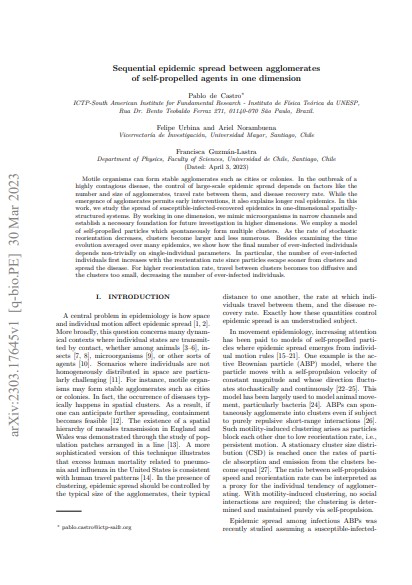Sequential epidemic-like spread between agglomerates of self-propelled agents in one dimension

Fecha
2023-10-02Autor
Castro, Pablo de
Urbina, Felipe [Univ Mayor, Centro Multidisciplinario de Física, Santiago, Chile]
Norambuena, Ariel [Univ Mayor, Centro Multidisciplinario de Física, Santiago, Chile]
Guzmán-Lastra, Francisca
Ubicación geográfica
Notas
HERRAMIENTAS
Acceda a títulos restringidos
¿Cómo descargar?Resumen
Motile organisms can form stable agglomerates such as cities or colonies. In the outbreak of a highly contagious disease, the control of large-scale epidemic spread depends on factors like the number and size of agglomerates, travel rate between them, and disease recovery rate. While the emergence of agglomerates permits early interventions, it also explains longer real epidemics. In this work, we study the spread of susceptible-infected-recovered (SIR) epidemics (or any sort of information exchange by contact) in one-dimensional spatially structured systems. By working in one dimension, we establish a necessary foundation for future investigation in higher dimensions and mimic micro-organisms in narrow channels. We employ a model of self-propelled particles which spontaneously form multiple clusters. For a lower rate of stochastic reorientation, particles have a higher tendency to agglomerate and therefore the clusters become larger and less numerous. We examine the time evolution averaged over many epidemics and how it is affected by the existence of clusters through the eventual recovery of infected particles before reaching new clusters. New terms appear in the SIR differential equations in the last epidemic stages. We show how the final number of ever-infected individuals depends nontrivially on single-individual parameters. In particular, the number of ever-infected individuals first increases with the reorientation rate since particles escape sooner from clusters and spread the disease. For higher reorientation rate, travel between clusters becomes too diffusive and the clusters too small, decreasing the number of ever-infected individuals.
URI
https://repositorio.umayor.cl/xmlui/handle/sibum/9468https://www.researchgate.net/publication/369740069_Sequential_epidemic_spread_between_agglomerates_of_self-propelled_agents_in_one_dimension
https://doi.org/10.1103/PhysRevE.108.044104
https://journals.aps.org/pre/abstract/10.1103/PhysRevE.108.044104
https://europepmc.org/article/MED/37978653
Coleccion/es a la/s que pertenece:
Si usted es autor(a) de este documento y NO desea que su publicación tenga acceso público en este repositorio, por favor complete el formulario aquí.